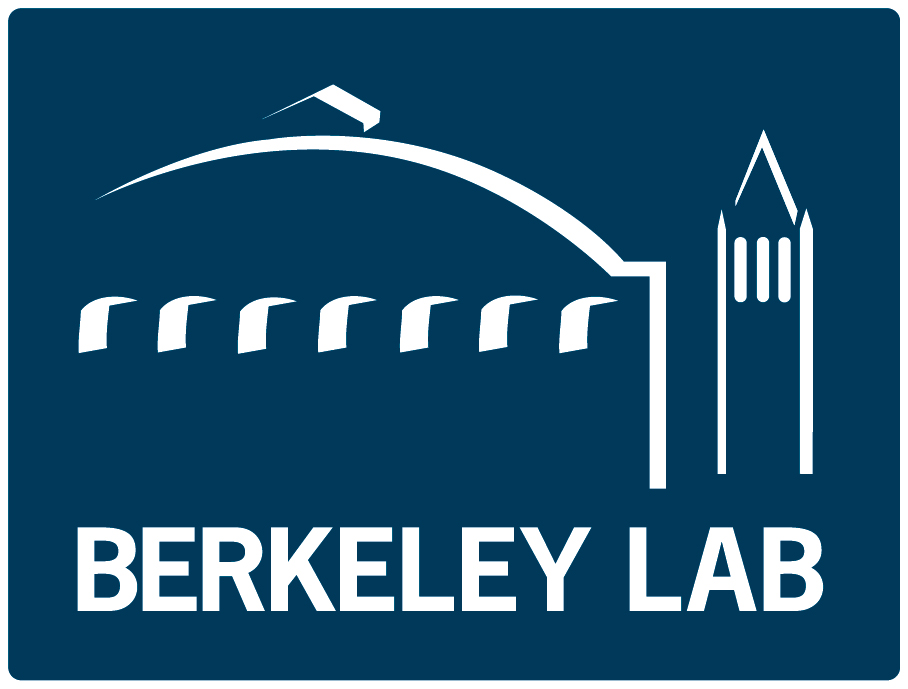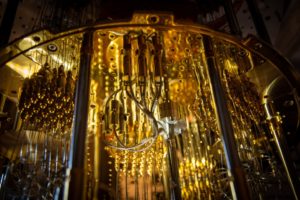Quantum Technologies
Quantum Materials
Low-phonon-energy Nanoparticles for Optical Imaging and Electronics (2023-018)
This invention is a novel class of low-phonon-energy nanoparticles, comprising lanthanide-doped alkali metal halides. These nanoparticles offer environmental stability, efficient doping with lighter lanthanides, and ultra-low phonon energies, enabling sub-wavelength resolution imaging (<100 nm) and optimization of various properties such as quantum yield, spectral purity, and coherence times.
Inventors: Zhuolei Zhang, Artiom Skripka, P. James Schuck, Bruce Cohen, Emory Chan
Contact: Lucian Sweitzer
Supramolecular Assembly of Halide Perovskite Blue Emitter for High-Yield, Tunable Optoelectronics (2022-127)
This invention is a method to stabilize the emission centers of halide perovskite components widely used in optoelectronics and lighting. These supramolecular assembled solids offer highly tunable emission colors, cost-effective synthesis in polar organic solvents at 80°C, and enhanced air stability compared to traditional vacancy-ordered double perovskites, making them promising for various applications.
Inventors: Peidong Yang, Cheng Zhu
Contact: Lucian Sweitzer
Quantum Computing
Hardware Efficient Randomized Compiling for Quantum Computing (2024-053)
This innovation simplifies noise management and reduces compilation time. Traditionally, Randomized Compiling (RC) is done in software, adding significant overhead. Our method implements RC directly on the Field Programmable Gate Array (FPGA) within the qubit control system, generating randomized operations and correction gates during execution. This approach eliminates software steps and cuts down the overall time required to run quantum circuits. The method has zero runtime overhead for most single-qubit gate implementations, and negligible compile time overhead, reducing the overall time complexity of compilation significantly. The increase in speed is about 250 times faster than standard state of the art systems.
Inventors: Gang Huang, Neelay Fruitwala, Akel Hashim, Yilun Xu, Abhi Rajagopala, Ravi Naik, Kasra Nowrouzi, Irfan Siddiqi
Contact: Sebastian Ainsle
Hardware-Assisted Parameterized Quantim Circuit Execution (2024-074)
This innovation improves quantum calibration, noise tailoring, and hybrid algorithms. It boosts execution efficiency by automatically identifying similar circuits and stitching parameters in hardware in real time. By reducing the classical computation bottleneck, it cuts execution time significantly. Perfect for quantum algorithms with batches of similar circuits, this method is essential as quantum systems scale. It can also be adapted for hybrid algorithms (quantum algorithms that contain classical quantum loops).
Inventors: Abhi Rajagopala, Neelay Fruitwala, Akel Hashim, Kasra Nowrouzi, Gang Huang, Yilun Xu, Irfan Siddiqi
Contact: Sebastian Ainsle
Superconducting-Oscillatory Neural Network with Pixel Error Detection for Image Recognition (2023-028)
This technology involves a superconducting oscillatory neural network for image recognition, using rapid single flux quantum technology. The innovative system features inductively coupled ring oscillators based on Josephson junctions, which operate at frequencies up to tens of GHz while consuming only a few attojoules per operation. This allows high speeds with low power consumption, offering energy-efficient neuromorphic computing capabilities.
Inventors: Dilip Vasudevan
Contact: Sebastian Ainsle
RSFQ Multiple Output Toggle Flip Flop for Area Efficient Superconducting Digital Computing (2023-037)
This invention is a multi-output TFF (True/False Flip-Flop) design that reduces the area, power, and latency of multiple types of compute and memory circuits by replacing circuits with tens of cells, leading to a TFF capable of more than two outputs.
Inventors: Meriam Gay Bautista, George Michelogiannakis, Darren Lyles, Patricia Gonzalez-Guerrero
Contact: Sebastian Ainsle
An Area-efficient Superconducting Unary Convolutional Neural Network (CNN) Accelerator for High Performance Computing Systems (2022-056)
This invention is a new approach to hardware acceleration for convolutional neural networks (CNNs) using superconducting chips. It leverages innovative race logic and pulse streams as the computational model foundation, significantly enhancing CNN computations’ efficiency.
Inventors: Patricia Gonzalez-Guerrero, Georgios Michelogiannakis
Contact: Sebastian Ainsle
Unary Single Flux Quantum (U-SFQ) Architecture for Scaling Superconducting Accelerators (2021-112)
This invention is the Unary Single Flux Quantum (U-SFQ) architecture, which utilizes pulse-streams and Race Logic (RL) to overcome the area constraints and complex architectures that limit current superconducting prototypes. Compared to current binary-based superconducting circuits, U-SFQ processes information up to 200 times more efficiently, requiring significantly fewer Josephson Junctions (JJs) and offering enhanced accuracy in noisy environments.
Inventors: Meriam Gay Bautista, Luisa Patricia Gonzalez-Guerrero, Darren Lyles, Georgios Michelogiannakis
Contact: Sebastian Ainsle
Quantum Instruction Set Architecture (QUASAR) (2021-061)
QUASAR, Quantum Instruction Set Architecture, is a software hardware interface for quantum computing. This facilitates a well-defined interface between quantum circuit software and hardware gate generation.
Inventor: Anastasiia Butko
Contact: Sebastian Ainsle
A Novel Design Method for On-Chip Superconducting Networks Using Race Logic (2021-009)
This invention is a novel design methodology enabling the creation of on-chip networks utilizing race logic, a time-domain computational model not previously utilized in network designs. By leveraging race logic’s manipulation of signal delays instead of binary encoding, this technology achieves significantly higher performance in superconducting circuits.
Inventors: Georgios Michelogiannakis, Darren Lyles, Dilip Vasusdevan, Patricia Gonzalez-Guerrero, Meriam Bautista.
Contact: Sebastian Ainsle
A Superconducting Quantum Processor Unit – A More Efficient Architecture for Quantum Computing (2020-121)
This invention integrates the controllability of superconducting circuits with programmable, all-to-all reconfigurable qubit connectivity, enabling the exploration and demonstration of various Noisy Intermediate-Scale Quantum (NISQ)-era quantum applications at scale.
Inventors: Irfan Siddiqi, Jie Luo, Brian Marinelli
Contact: Sebastian Ainsle
A New Design for RSFQ Superconducting Logic Computation Systems (2020-015)
This invention merges superconducting logic, temporal predicate logic, and delay-based codes to design temporal logic computation primitives in rapid single flux quantum (RSFQ) superconducting logic. By introducing a new data-driven-self timed scheme (DDST), clock distribution overhead in traditional RSFQ logic cells is significantly reduced.
Inventors: Dilip Vasudevan, Georgios Michelogiannakis, John Shalf
Contact: Sebastian Ainsle
Scalable Quantum Computer Architecture with Coupled Donor-Quantum Dot Qubits (IB-3140)
This quantum computing architecture employs single spin memory donor atoms embedded in a semiconductor layer, along with quantum dots arranged and aligned with these donor atoms. By applying voltages across aligned pairs of quantum dots and donor atoms, the coupling between them is controlled, enabling quantum computing operations.
Inventors: Jeffrey Bokor, Cheuk Chi Lo, Stephen Lyon, Thomas Schenkel, Alexei Tyryshkin, Christoph D Weis
Contact: Lucian Sweitzer
Tunable Graphene Electronic Devices (JIB-2697)
This invention introduces a method to induce two-dimensional superconductivity in graphene sheets and adjust their material characteristics using an electrostatic gate. By leveraging the electric-field effect of graphene, the coupling between order parameter inducing islands can be modified, offering a simpler alternative to traditional methods requiring changes in material composition or pressure. This approach enables precise control over the properties of electronic devices, facilitating applications such as photoelectric characteristics, chemical specificity, spintronics, and superconductivity.
Inventors: Jeffrey Bokor, Cheuk Chi Lo, Stephen Lyon, Thomas Schenkel, Alexei Tyryshkin, Christoph D Weis
Contact: Lucian Sweitzer

